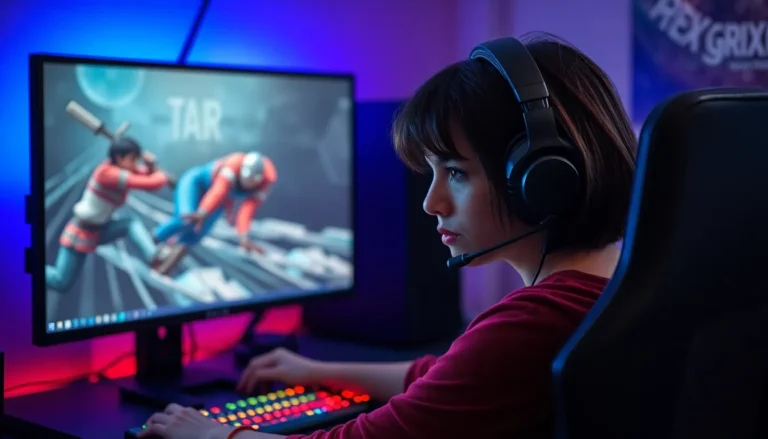Table of Contents
ToggleEver found yourself in a digital rabbit hole, frantically searching for that brilliant chat you had with ChatGPT about the meaning of life or the best pizza toppings? It’s like losing your favorite sock in the laundry—frustrating and a bit bewildering. But fear not! Understanding where your ChatGPT history is hiding can save you from the agony of trying to remember that witty exchange.
Understanding ChatGPT History
ChatGPT history refers to the record of conversations and interactions users have with the AI. This function helps users revisit past discussions to find valuable insights.
What Is ChatGPT History?
ChatGPT history is the collection of dialogues exchanged between users and the AI. Each conversation is stored for easy access, allowing users to retrieve previous inquiries and responses. It serves as a digital archive, helping keep track of valuable information shared during interactions.
Importance of ChatGPT History
ChatGPT history plays a critical role in optimizing user experience. By reviewing past conversations, users can recap important insights quickly. This feature enhances continuity, making it easier to build upon previous discussions. Retaining access to conversation history prevents the frustration of having to repeat questions. Users can also improve their query formulations by analyzing earlier interactions. Overall, understanding this history streamlines and enriches ongoing conversations with the AI.
Locating Your ChatGPT History
Finding your ChatGPT history is straightforward, making it easier to revisit insightful conversations. Efficient retrieval of past interactions enhances user experience.
Accessing the ChatGPT Interface
To locate the history, first, log in to the ChatGPT platform. Accessing the main interface displays previous sessions prominently. Users can see a list of past conversations on the left side of the screen. Clicking any session retrieves the dialogue. Additional features on this interface allow adjustments to preferences, streamlining ongoing interactions.
Navigating the Settings Menu
The settings menu provides options for managing history. After clicking the profile icon, select “Settings” from the dropdown. Within the menu, users find the “Data Controls” section. Options here enable users to view or delete conversation history as preferred. Adjusting these settings optimizes how interactions are stored and accessed in the future.
Common Issues with ChatGPT History
Users often encounter challenges when accessing their ChatGPT history. Understanding these common issues can help enhance their interactions and overall experience.
Missing History Records
Missing records may occur due to various factors. Sessions not saved properly can lead to lost conversations. Network interruptions during usage pose another risk, causing incomplete entry archives. Users must also ensure they are logged into the correct account when attempting to retrieve history. If the platform experiences technical difficulties, it can hinder access to stored dialogues. Exploring settings may uncover preferences that influence visibility.
Privacy Settings and History
Privacy settings significantly impact the visibility of ChatGPT history. Users can choose to delete past conversations, which permanently removes content from their records. Adjusting privacy settings may also restrict the collection of history data, reducing the information accessible later. Each user must balance their privacy concerns with the desire to maintain a robust chat record. Some users may not realize that disabling history affects future interactions, which can limit context during discussions. Understanding these settings allows users to manage their history effectively and align with personal privacy preferences.
Best Practices for Managing ChatGPT History
Effective management of ChatGPT history enhances user experience and ensures easy access to past interactions.
Regularly Reviewing Your History
Regular reviews of conversation history keep important information easily accessible. Users should take time to revisit past discussions for valuable insights. Each interaction often contains key ideas that can improve future queries. By analyzing earlier messages, users can refine their question formulation and discover new perspectives. Checking history periodically helps maintain a connection with earlier discussions, aiding in continuity. Consistent review not only boosts efficiency but ensures that users maximize the benefits of past exchanges.
Deleting Unwanted Conversations
Deleting unwanted conversations prevents clutter in the ChatGPT history. Users can eliminate any chats that no longer hold relevance or contain sensitive information. This process keeps the chat record organized and straightforward. Accessing the settings menu allows for quick deletion of specific sessions. Transparency in managing history supports both privacy and user control. Ensuring only meaningful conversations remain helps users focus on the most relevant insights, optimizing future interactions with the AI.
Finding and managing ChatGPT history is essential for users who want to make the most of their interactions. By knowing how to access past conversations and utilizing the available tools, they can easily revisit important insights and maintain continuity in their discussions.
Regularly reviewing chat history not only enhances the user experience but also supports better question formulation. Balancing privacy settings with effective history management allows users to keep their conversations organized and meaningful.
With a clear understanding of how to navigate ChatGPT history, users can optimize their future interactions and avoid the frustration of lost insights.







